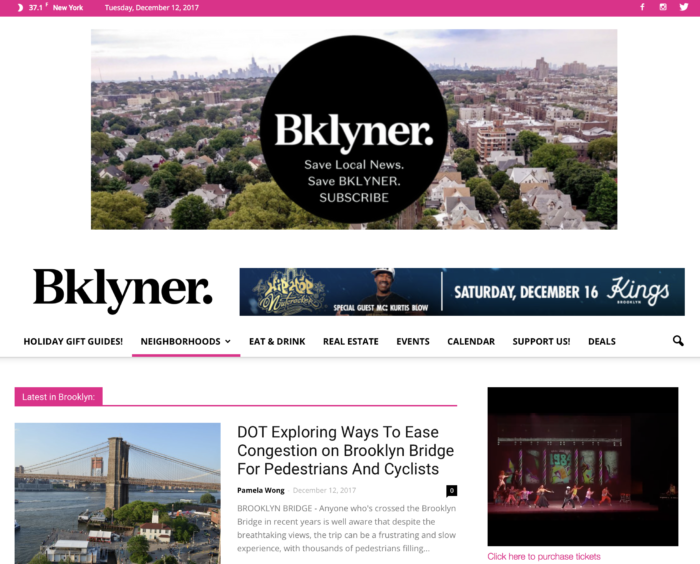Inside a Brooklyn News Site’s Last-ditch Campaign
BKLYNER planned to shut down at the end of the month unless it could recruit 3,000 paying subscribers. Here's what happened
Says Liena Zagare, editor and publisher of BKLYNER: “Without reader support I think there is absolutely no future for local journalism” (Photo by Chester Higgins Jr./The New York Times/Redux)
If you like your cheese, your bourbon, and your chocolate locally sourced—chances are you like your news local, too.
Another New York City local-news organization is in trouble, and they’re asking for reader support. Just last month, Gothamist and DNAinfo were shut down—and temporarily taken offline as well, though now the archives are back up and can be accessed. That death knell came after Gothamist’s spring sale to billionaire Joe Ricketts, founder of DNAinfo, and the decision by the digital newsrooms to unionize. The fight did not end well, and after 14 years and tens of thousands of articles, the formerly Dumbo-based Gothamist is dead.
Now BKLYNER, a reporting-driven local news site for all things Brooklyn, is also on the verge of a shutdown. On Dec. 6, editor and publisher Liena Zagare announced on BKLYNER’s newsletter list and on the site, “We cannot make ends meet under our current advertising-based business model. Like hundreds of other news outlets around the country, we’ve found it impossible to sustain a robust news organization on local ad sales alone.”
There wasn’t much warning—if they don’t reach their goal of 3,000 subscribers (only 1% of their total readership, Zagare says), the site will close by Dec. 31. The news likely comes as a surprise to readers, though it shouldn’t. It’s easy to take for granted something that’s free and not consider how the sausage is made. “In 2017, local independent media sources like ours are in real trouble,” Zagare wrote. “Revenue from advertising and classifieds that once fueled local news is now being lost to Facebook, Google, and other global internet giants. We cut our costs deeply last year, but it wasn’t enough.” Update on Jan. 3: by year’s end, BKLYNER drew 1,745 paying subscribers and decided to stay in business.
We got in touch with Zagare for more details about her decision—and she’s blunt and realistic: “Without reader support I think there is absolutely no future for local journalism.”
Q: You’ve been running local news sites for awhile now. How has the business changed?
Zagare: It has changed immensely! I started ditmasparkblog on Blogger as a hobby. It grew and I have been trying to figure out how to make neighborhood news profitable (or to at least break even) ever since. For a while, working with small businesses worked—once you had critical mass of readership, they knew where to find you. But it was never quite sufficient to offer a reporter a steady job. We started working with larger institutions and the city. We consolidated the business end of a number of sites. We could still not make ends meet. So then, this time last year, we tried asking neighbors for subscriptions before folding all the sites into one: BKLYNER. We got 52 subscribers.
What made you decide now was the time to turn to reader support? Was there a straw-that-broke-the-camel’s-back moment?
We could do no more with what we have, and what we do is barely sufficient and a far cry from how good local news can be in Brooklyn. We do excellent journalism—just this year we uncovered an oil spill that led to new laws being introduced by the local council member. But there simply is not enough of us. We took a good look at our finances and realized revenue was so unpredictable we could offer no one steady work going forward. And that would mean even less–and more ad hoc–reporting. And that was simply not something we could put our name to. So our last hope is that we have enough readers step up to support us. Just 1% would be enough.
Anything else you’d like readers to know?
That whether you choose to support BKLYNER or another news site, you should become subscribers. The classifieds and listings and ads that funded journalism, including much of digital journalism, have largely gone to Facebook and Google. To be sustainable, journalism needs a predictable revenue stream from those who value it most: readers. That applies to the New York Times and that applies to local. At the end of the day, it is all painstaking, time-consuming, and labor-intensive reporting, whether you cover the community board or Congress.
BKLYNER is a site where a crime blotter exists next to neighborhood restaurant openings with ease. It’s colorful and vital and necessary. It’s very Brooklyn. Where else but locally can you still read about such varied happenings as the disappearance of the iconic Watchtower sign, or the son-of-a-son-of-a-candymaker running the chocolate shop JoMart Chocolates in Marine Park (in business 71 years and counting), or a story headlined “The Manhattan Bombing Terrorist Lived In My Neighborhood,” by a Muslim journalist? These detailed local stories can make someone fall in love with—and become more educated about—the borough they call home.
BKLYNER was launched in January 2017 as a consolidation of a number of other local blogs (Ditmas Park Corner, Sheepshead Bites, Bensonhurst Bean, Park Slope Stoop, South Slope News, KensingtonBK, Sunset Park Voice, and Fort Greene Focus), some of which dated back to 2008. Currently, BKLYNER employs five staffers and has about a dozen regular contributors.
When legacy news organizations like the New York Times, Wall Street Journal and Washington Post first started charging digital readers for access a few years ago, critics thought the penny-pinching public wouldn’t bite. And indeed, they didn’t. At first. But now it’s become more than acceptable for a monthly charge for news to sit next to your Hulu or Netflix charge on your credit-card bill. But as those publications have pursued paying customers around the globe, they have tended to shift their focus away from local reporting.
Since the news went around last week, Zagare says nearly 600 people have become subscribers and the outpouring of support has been heartening. The site is not planning to enact a paywall, so the ongoing subscription ($5 per month, or $60 per year) is more like a donation.
In an era where people—or, maybe, one person in particular—screams “Fake news!” on the regular, it’s not only necessary, but vital to support local-news organizations that cover the vibrancy and depth of what’s actually going on in Brooklyn. Because if you don’t know what’s going on around you, what’s the point of living here?
While it’s easy to support local Brooklyn businesses by picking up a borough-made scarf or pair of sunglasses (hey, we do have a nice-looking gift guide filled with worthwhile swag), you can also consider putting money towards a reporter’s salary, and helping keep alive a business that casts a discerning eye on every nook in the borough.
As Zagare wrote to her readers, “We’re not giving up just yet. That’s not what Brooklynites do.” It may be too late to save Gothamist, but it’s not too late to keep BKLYNER alive.
Liena Zagare discusses the future of BKLYNER and the difficulties of sustaining local news. (Video by BRIC TV)











